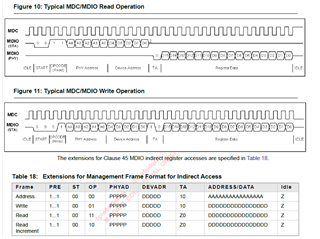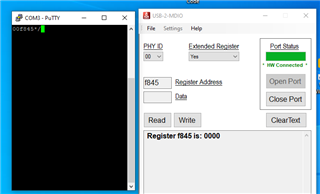Other Parts Discussed in Thread: MSP-EXP430G2ET
Hello,
I want to use USB-2-MDIO GUI with MSP-EXP430G2ET launchpad to access registers of a PHY. This PHY is not from Texas instrument.
This PHY (marvell 88x5113) has MDIO/MDC access to his registers using indirect access specified by IEEE Clause 45.
please find below explanation from Marvell datasheet:

I should provide the PHY address, Device address and register address. But on the GUI there is nowhere to provide the device address
My question is :
- is it possible to access to the extended registers using the GUI USB-2-MDIO ?? i know there is a field to choose extended register but my main concern is that I should provide device address.
- if not, is there a way to use commands or script to do it ?
This topic has be discussed here, but this was regarding a TI PHY, which is not my case.
Please if you have any idea or material this would be helpful
Thank you !
NOTE: i had an idea:
Let say i want to read register 0xF845, PHY address=b00000 (0x00) , DEVICE address=b11111 (0x1f)
STEP 1:
I should access with not extended register , the mdio clause 22 described below

so in order to read the register I would:
1/ write to register 0x1f (my device address) value 0xF845 (my register address)
2/read register 0x1F
a read is op=10 and write op=01 instead of the fist write I should use operation =00 that sets the address but unfortunately I don't have this choice using the GUI
STEP 2:
I had the idea maybe I should send direct serial commands to the MSP-EXP430G2ET without interfacing with the GUI. With this manner I should find the correct serial command to send to the MSP-EXP430G2ET where the MSP-EXP430G2ET will be able to translate it to the wanted MDIO frame. (and set operation bits b00)
I first spied the serial command send by USB-2-MDIO, it looks like that:

read extended register PHY 00, register f845 --> 00f845*/
read not extended register PHY 00, register f845 --> 00f845=/
write extended register PHY 00, register f845, value 0xa4 --> 00f84500a4*/
Unfortunately the serials commands are basics, it's still high level approach so is seems there is no way to control the exact MDIO command.

